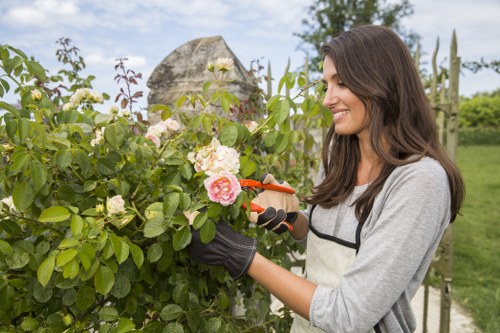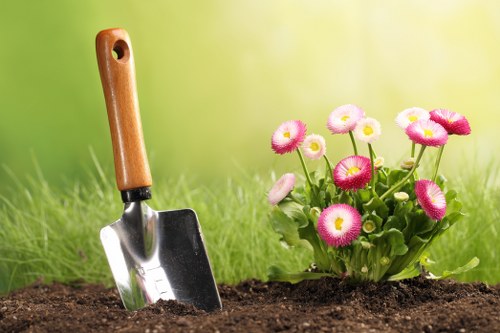Transform Your Outdoor Space: Landscaping in Swiss Cottage

Swiss Cottage, a charming area renowned for its picturesque streets and vibrant community, offers numerous opportunities for homeowners to enhance their outdoor living spaces. Landscaping in Swiss Cottage is not just about aesthetics; it's about creating a harmonious environment that complements the local architecture and natural surroundings.
Whether you're looking to redesign your garden, install a new patio, or simply add some greenery, understanding the unique characteristics of Swiss Cottage can help you make informed decisions. This guide explores the essential aspects of landscaping in Swiss Cottage, providing you with the insights needed to create a stunning and sustainable outdoor space.
From selecting the right plants to incorporating modern design elements, we'll cover everything you need to know to achieve a beautiful landscape that thrives in the Swiss Cottage climate.

Understanding the Swiss Cottage Climate
One of the first steps in successful landscaping is understanding the local climate. Swiss Cottage experiences a temperate climate with distinct seasons, including cold winters and warm summers. This variation affects plant selection, garden maintenance, and overall landscape design.
Choosing plants that are resilient to temperature fluctuations ensures that your garden remains vibrant throughout the year. Perennials, shrubs, and trees that can withstand both the chill of winter and the heat of summer are ideal choices for Swiss Cottage gardens.
- Cold-Hardy Plants: Consider plants like lavender, holly, and peonies that can survive low temperatures.
- Drought-Tolerant Varieties: Plants such as sedum, coneflowers, and ornamental grasses are excellent for areas with limited water.
- Seasonal Blooms: Incorporate flowers that bloom in different seasons to maintain color and interest year-round.

Design Principles for Effective Landscaping
Effective landscaping is anchored in strong design principles. These principles guide the arrangement of plants, structures, and features to create a cohesive and functional outdoor space.
Balance is essential to ensure that no single element overwhelms the others. Symmetrical and asymmetrical balance can both be employed to create visual interest.
Unity ensures that all elements of the garden work together harmoniously. Consistent use of materials, colors, and plant types fosters a unified look.
Creating Focal Points
A focal point draws the eye and serves as the centerpiece of your landscape. It could be a beautiful tree, a striking sculpture, a water feature, or a well-designed patio area.
- Water Features: Ponds, fountains, and waterfalls add movement and sound to the garden.
- Sculptures: Artistic elements can provide unique visual interest.
- Statement Plants: A large or unusually colored plant can serve as a natural focal point.

Plant Selection for Swiss Cottage Gardens
Selecting the right plants is crucial for a thriving landscape. Consider native species that are well-adapted to the local climate and soil conditions. Native plants often require less maintenance and are more resistant to pests and diseases.
Incorporate a mix of evergreen and deciduous plants to ensure year-round interest. Evergreen shrubs provide structure and color during the winter months, while deciduous trees and plants offer seasonal blooms and foliage changes.
Flowering Plants
Flowering plants add color and vibrancy to your garden. Choose a variety of flowers that bloom at different times to maintain continuous color throughout the growing season.
- Spring Bloomers: Daffodils, tulips, and primroses herald the arrival of spring.
- Summer Flowers: Roses, daisies, and sunflowers thrive in the summer heat.
- Autumn Colors: Chrysanthemums, asters, and marigolds bring warmth to the fall landscape.
Shade and Sun Plants
Consider the light conditions of your garden when selecting plants. Some plants thrive in full sun, while others prefer the shade. Grouping plants with similar light requirements together ensures they flourish.
- Sun-Loving Plants: Lavender, agapanthus, and coneflowers prefer full sunlight.
- Shade-Tolerant Varieties: Hostas, ferns, and impatiens are ideal for shaded areas.

Hardscaping Elements
Hardscaping refers to the non-living elements of your landscape, such as patios, walkways, walls, and fences. These elements provide structure and functionality, complementing the softscape of plants and flowers.
Choosing the right materials and designs for hardscaping can enhance the overall aesthetic and usability of your outdoor space. Popular materials in Swiss Cottage include natural stone, brick, and treated wood, which blend seamlessly with the local environment.
Patios and Decks
Patios and decks provide spaces for outdoor living and entertaining. Consider the layout and materials carefully to ensure they complement your home's architecture and the surrounding landscape.
- Stone Patios: Offer a timeless and durable surface.
- Wooden Decks: Provide a warm and inviting atmosphere.
- Composite Materials: Low-maintenance options that mimic the look of natural materials.
Walkways and Paths
Walkways guide visitors through your garden and connect different areas of your landscape. Curved paths can create a sense of discovery, while straight paths offer a more formal look.
- Brick Paths: Classic and enduring.
- Gravel Walkways: Provide a rustic charm.
- Stone Slabs: Add elegance and sophistication.

Sustainable Landscaping Practices
As environmental concerns grow, sustainable landscaping becomes increasingly important. Implementing eco-friendly practices not only benefits the environment but can also reduce maintenance costs and enhance the health of your garden.
Integrate sustainable methods such as rainwater harvesting, composting, and the use of native plants to create a resilient and low-impact landscape.
Water Conservation
Efficient water use is crucial in sustainable landscaping. Implementing irrigation systems that minimize water waste, such as drip irrigation, ensures that your plants receive the necessary hydration without excess runoff.
- Rain Gardens: Capture and utilize rainwater to nourish plants.
- Mulching: Reduces evaporation and keeps soil moist.
- Drought-Resistant Plants: Select plants that require minimal watering.
Soil Health
Healthy soil is the foundation of a thriving garden. Regularly amend your soil with organic matter, such as compost or manure, to improve its structure and fertility.
- Composting: Recycles kitchen and garden waste into nutrient-rich soil.
- Cover Crops: Plants like clover or rye protect and enrich the soil.
- Reduced Tillage: Minimizes soil disturbance and promotes microbial activity.
Native and Invasive Species
Planting native species supports local wildlife and reduces the need for excessive care. Avoid invasive species that can disrupt local ecosystems and outcompete native flora.
- Native Trees and Shrubs: Provide habitat and food for native birds and insects.
- Invasive Control: Regular maintenance to prevent the spread of invasive plants.

Professional Landscaping Services in Swiss Cottage
While DIY landscaping can be rewarding, professional landscaping services offer expertise and efficiency that can transform your outdoor space. Professionals bring a wealth of knowledge in design, plant selection, and maintenance, ensuring that your garden not only looks beautiful but is also sustainable and easy to care for.
When choosing a landscaping service in Swiss Cottage, consider their portfolio, customer reviews, and the range of services they offer. A reputable provider will work closely with you to understand your vision and bring it to life.
Design Consultation
A design consultation allows professionals to assess your space and discuss your ideas. They can provide valuable insights and suggestions to optimize your landscape.
- Site Analysis: Evaluating soil, light, and existing structures.
- Customized Plans: Tailored designs that reflect your style and needs.
- Budget Planning: Ensuring your landscaping project fits within your financial constraints.
Implementation and Installation
Professional landscapers handle the installation of all elements, from planting to hardscaping. Their expertise ensures that each component is correctly placed and installed for maximum longevity and aesthetic appeal.
- Planting: Proper placement and spacing for optimal growth.
- Hardscaping: Precise installation of patios, walkways, and other structures.
- Irrigation Systems: Efficient setup to support plant health.
Maintenance Services
Ongoing maintenance is essential for keeping your landscape pristine. Many landscaping services offer regular maintenance packages that include pruning, weeding, mulching, and seasonal plant care.
- Seasonal Clean-Up: Preparing your garden for each season.
- Regular Pruning: Ensuring plants grow healthily and maintain their shape.
- Pest Management: Protecting your plants from harmful insects and diseases.

Incorporating Technology in Landscaping
Modern technology has revolutionized landscaping, making it easier to design, manage, and maintain outdoor spaces. From smart irrigation systems to landscape design software, technology plays a significant role in contemporary landscaping practices.
Integrating technology into your landscaping project can enhance efficiency, sustainability, and overall garden health.
Smart Irrigation Systems
Smart irrigation systems use sensors and weather data to optimize watering schedules. This ensures that your plants receive the right amount of water, reducing waste and promoting healthy growth.
- Weather-Based Adjustments: Automatically adjusting watering based on rainfall and temperature.
- Remote Control: Managing your irrigation system through smartphone apps.
- Water Usage Monitoring: Tracking water consumption to identify inefficiencies.
Landscape Design Software
Design software allows homeowners and professionals to create detailed plans and visualizations of their landscaping projects. This technology helps in visualizing the final outcome and making necessary adjustments before implementation.
- 3D Modeling: Creating realistic representations of your garden.
- Design Flexibility: Experimenting with different layouts, plants, and structures.
- Collaboration: Sharing designs with professionals for feedback and refinement.
Automated Maintenance Tools
Automated tools, such as robotic lawn mowers and smart lighting systems, streamline garden maintenance. These tools save time and ensure that your landscape remains well-maintained with minimal effort.
- Robotic Mowers: Keeping your lawn neat and trim without manual effort.
- Smart Lighting: Enhancing your garden's ambiance with programmable lighting schedules.
- Automated Fertilizers: Delivering nutrients to plants as needed.

Enhancing Curb Appeal
Your home's curb appeal is the first impression visitors and potential buyers have of your property. Effective landscaping plays a crucial role in enhancing curb appeal, making your Swiss Cottage home stand out in the neighborhood.
Simple changes, such as adding colorful flowers, updating pathways, or installing new lighting, can significantly boost your home's exterior appearance.
Entryway Enhancements
The entryway is a focal point of your home's exterior. By enhancing this area, you create a welcoming atmosphere.
- Pathways: Create clear and attractive paths leading to your front door.
- Lighting: Install lighting to highlight architectural features and improve safety.
- Planting Beds: Use a mix of plants to add color and texture around the entrance.
Driveways and Parking Areas
A well-maintained driveway or parking area adds to the overall appearance of your property. Incorporate materials and designs that complement your home's style.
- Decorative Pavers: Enhance the look of driveways with patterned pavers.
- Border Plants: Use plants to define and beautify parking areas.
- Functional Lighting: Ensure visibility and safety with appropriate lighting.
Seasonal Decorations
Seasonal decorations can refresh your landscape's look throughout the year. Simple additions like wreaths, seasonal plants, and lighting can make a big difference.
- Spring: Tulips, daffodils, and bright annuals.
- Summer: Vines, vibrant flowers, and lush greenery.
- Autumn: Colorful foliage and pumpkins.
- Winter: Evergreens, twinkling lights, and festive ornaments.

DIY Landscaping Tips
For those who prefer a hands-on approach, DIY landscaping can be both fulfilling and cost-effective. Here are some practical tips to help you create a beautiful landscape in Swiss Cottage.
Planning and preparation are key to successful DIY landscaping. Take the time to outline your goals, create a design plan, and gather the necessary tools and materials before starting.
Planning Your Landscape
Begin by assessing your outdoor space, noting areas that receive ample sunlight, shade, and different soil types. Sketch a layout that includes plant placements, hardscape elements, and feature areas.
- Measure Your Space: Accurate measurements ensure that plants and structures fit appropriately.
- Create a Design Plan: Outline where each element will be placed.
- Set a Budget: Determine how much you're willing to spend on materials and plants.
Choosing the Right Tools
Having the right tools makes landscaping tasks easier and more efficient. Essential tools include:
- Shovels and Spades: For digging and planting.
- Pruners and Shears: For trimming plants and shaping shrubs.
- Rakes and Hoes: For leveling soil and removing debris.
- Wheelbarrows: For transporting soil, plants, and materials.
Planting and Maintenance
Proper planting techniques and regular maintenance are crucial for a healthy garden. Follow these steps to ensure your plants thrive:
- Soil Preparation: Amend the soil with compost or fertilizer to provide nutrients.
- Planting: Dig holes that are twice as wide as the root ball and plant at the same depth as in the pot.
- Watering: Water thoroughly after planting and maintain consistent moisture levels.
- Mulching: Apply mulch to retain moisture and suppress weeds.
- Regular Pruning: Trim plants to promote healthy growth and prevent overgrowth.

Maximizing Small Spaces
Not everyone has a sprawling garden, but even small outdoor spaces can be transformed into beautiful landscapes. Maximizing small spaces in Swiss Cottage involves creative design and thoughtful plant selection.
Use vertical gardening, compact plant varieties, and multifunctional furniture to make the most of limited space.
Vertical Gardening
Vertical gardens utilize walls, trellises, and other vertical structures to grow plants upwards, saving ground space and adding lush greenery to your outdoor area.
- Wall Planters: Attach planters to walls for herbs, flowers, or small vegetables.
- Trellises: Support climbing plants like ivy, roses, and peas.
- Hanging Baskets: Add color and texture without taking up floor space.
Compact Plant Varieties
Select plants that are naturally small or have a slow growth rate to fit within limited spaces. Dwarf varieties of trees and shrubs can provide structure without overwhelming the area.
- Dwarf Conifers: Offer year-round greenery in a compact form.
- Small-Scale Perennials: Provide seasonal color without excessive height.
- Container Plants: Easily movable and suitable for various small spaces.
Multifunctional Furniture
Choose furniture that serves multiple purposes, such as benches with storage or tables with built-in planters. This approach maximizes functionality without cluttering the space.
- Foldable Furniture: Saves space when not in use.
- Integrated Planters: Combine seating with plant displays.
- Vertical Storage: Utilize wall-mounted shelves for gardening tools and decor.
Lighting and Accessories
Strategic lighting and accessories can enhance small landscapes, making them feel larger and more inviting.
- String Lights: Add ambiance without taking up space.
- Solar-Powered Fixtures: Eco-friendly lighting options that require minimal installation.
- Mirrors: Reflect light and create the illusion of more space.

Seasonal Landscaping Tips
Maintaining a vibrant landscape in Swiss Cottage requires attention to seasonal changes. Each season brings its own set of challenges and opportunities for enhancing your garden.
Adapting your landscaping efforts to the changing seasons ensures your outdoor space remains beautiful and healthy throughout the year.
Spring Landscaping
Spring is a time of renewal, making it ideal for planting new flowers and preparing your garden after winter.
- Planting: Introduce spring bulbs, annuals, and perennials.
- Soil Preparation: Turn over the soil and add compost to enrich it.
- Pruning: Trim back dead branches and shape shrubs.
Summer Care
Summer brings heat and growth. Focus on watering, mulching, and controlling pests to keep your garden thriving.
- Watering: Ensure plants receive adequate moisture, especially during dry spells.
- Mulching: Retain soil moisture and regulate temperature.
- Pest Control: Monitor for and manage common garden pests.
Autumn Maintenance
Autumn is the perfect time to prepare your garden for the colder months. Clean up fallen leaves and plant hardy species that will withstand winter conditions.
- Leaf Removal: Prevent mold and pests by keeping gardens tidy.
- Planting: Introduce bulb plants and shade-tolerant plants.
- Pruning: Shape trees and shrubs before they go dormant.
Winter Preparation
While winter can be challenging, strategic planning can keep your garden protected and ready for the next growing season.
- Protective Coverings: Use burlap or frost cloths to shield delicate plants.
- Tool Maintenance: Clean and store gardening tools properly.
- Planning: Outline new landscaping projects for the spring.

Budget-Friendly Landscaping Ideas
Creating a beautiful landscape doesn't have to be expensive. With thoughtful planning and creative ideas, you can transform your outdoor space in Swiss Cottage without breaking the bank.
Implementing budget-friendly landscaping techniques allows you to enjoy a stunning garden while managing costs effectively.
Use Native Plants
Native plants are often more affordable because they are readily available and adapted to the local climate, requiring less maintenance and fewer resources.
- Lower Cost: Native plants typically cost less and are easier to care for.
- Environmental Benefits: Support local wildlife and reduce the need for pesticides and fertilizers.
- Resilience: Better withstand local pests and weather conditions.
Repurpose Materials
Reusing materials can add unique character to your landscape while saving money.
- Salvaged Wood: Create garden beds, pathways, or retaining walls.
- Recycled Containers: Use old tires, pallets, or buckets as planters.
- Found Objects: Incorporate items like old furniture or decorative pieces for a personalized touch.
DIY Projects
Engaging in DIY landscaping projects can significantly reduce costs and add a sense of accomplishment to your gardening efforts.
- Building Raised Beds: Construct your own raised garden beds using affordable materials.
- Creating Compost: Make your own compost to enrich soil without purchasing fertilizers.
- Installing Pathways: Lay down gravel or mulch pathways instead of expensive paving stones.
Minimalist Design
A minimalist approach focuses on simplicity and functionality, often resulting in cost savings.
- Fewer Plants: Select a few statement plants instead of many smaller ones.
- Simple Structures: Opt for basic hardscape elements that are easy to install.
- Clean Lines: Use straight lines and geometric shapes for a modern and uncluttered look.
Monthly Maintenance
Regular maintenance prevents costly repairs and replacements down the line. Spending time each month on upkeep tasks can keep your landscape looking its best.
- Weeding: Prevent weeds from taking over your garden.
- Pruning: Maintain plant health and aesthetics.
- Mulching: Replenish mulch to retain soil moisture and suppress weeds.

Choosing the Right Landscaping Contractor
Hiring the right landscaping contractor is crucial to the success of your project in Swiss Cottage. A reputable contractor brings expertise, efficiency, and creativity to your outdoor space, ensuring that your vision is realized effectively.
Here are key factors to consider when selecting a landscaping professional:
Experience and Expertise
Choose a contractor with extensive experience in landscaping, particularly in the Swiss Cottage area. Their familiarity with local conditions and trends can greatly benefit your project.
- Portfolio: Review their past projects to assess their style and quality.
- Specializations: Some contractors may specialize in certain areas such as hardscaping, garden design, or sustainable landscaping.
- Certifications: Look for relevant licenses and certifications that demonstrate professionalism and expertise.
Reputation and Reviews
A contractor's reputation is a strong indicator of the quality of their work. Seek feedback from past clients to gauge their satisfaction and reliability.
- Online Reviews: Check platforms like Google, Yelp, and local directories for customer feedback.
- References: Ask the contractor for references you can contact directly.
- Word of Mouth: Personal recommendations from friends and neighbors can be invaluable.
Transparency and Communication
Effective communication ensures that both you and the contractor are on the same page throughout the project. Clear and transparent discussions about expectations, timelines, and costs are essential.
- Detailed Quotes: Obtain comprehensive estimates that outline all costs involved.
- Regular Updates: Expect consistent communication and progress reports.
- Contract: Ensure that all terms and conditions are clearly documented in a written agreement.
Cost and Value
While cost is an important factor, it shouldn't be the sole determinant. Consider the value offered in terms of quality, expertise, and the overall outcome of the project.
- Competitive Pricing: Compare quotes from multiple contractors to ensure you're getting a fair price.
- Quality of Materials: Higher-quality materials may have a higher upfront cost but offer better longevity and aesthetics.
- Value-Added Services: Additional services such as design consultations or maintenance packages can enhance overall value.

Conclusion: Elevate Your Swiss Cottage Landscape
Landscaping in Swiss Cottage presents a unique opportunity to create a beautiful, sustainable, and functional outdoor space. By understanding the local climate, applying effective design principles, selecting suitable plants, and incorporating both hardscaping and technological innovations, you can transform your garden into a stunning oasis.
Whether you opt for DIY projects or seek professional landscaping services, the key is to plan thoughtfully and execute with care. Embrace sustainable practices to ensure your landscape thrives for years to come, and don't hesitate to reach out to local experts who can guide you through the process.
Ready to transform your outdoor space? Contact us today to start your landscaping journey in Swiss Cottage. Let our experts help you create the garden of your dreams.
Additional Resources
- Local Nurseries: Visit Swiss Cottage nurseries for native plants and gardening advice.
- Community Gardens: Join local community gardens to gain inspiration and share ideas.
- Workshops and Classes: Attend landscaping workshops to enhance your skills and knowledge.
